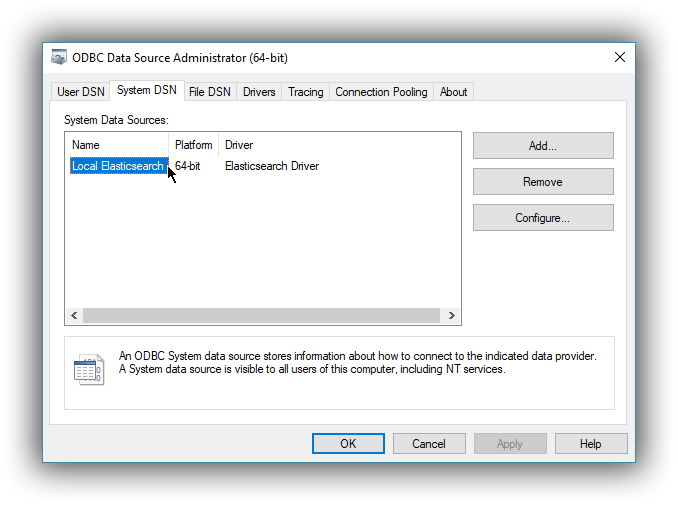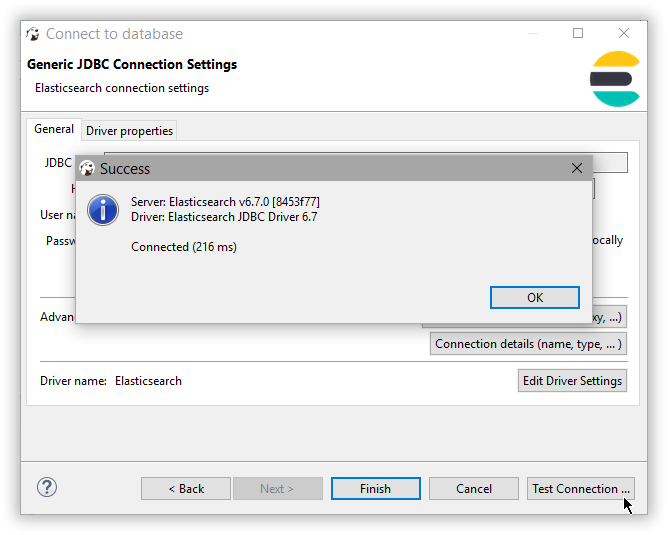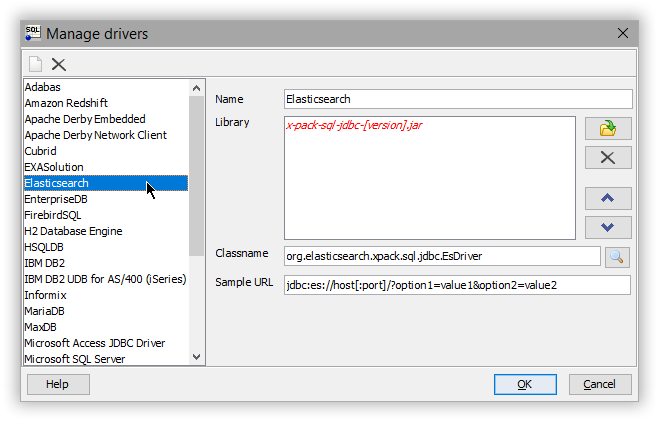DBeaver is aware of the Elasticsearch JDBC maven repository so simply Download/Update the artifact or add a new one. As an alternative one can add a local file instead if the Elasticsearch Maven repository. Rapidly create and deploy powerful Java applications that integrate with Elasticsearch. Manage Elasticsearch data with visual tools in DBeaver like the query browser. The CData JDBC Driver for Elasticsearch implements JDBC standards that enable third-party tools to interoperate, from wizards in IDEs to business intelligence tools. 云原生数据湖分析(简称DLA)是新一代大数据解决方案,采取计算与存储完全分离的架构,支持数据库(RDS PolarDB NoSQL)与消息实时归档建仓,提供弹性的Spark与Presto,满足在线交互式查询、流处理、批处理、机器学习等诉求,也是传统Hadoop方案上云的有竞争力的解决方案。. In this blog post, I’ll discuss how to install DBeaver Database Tool on Ubuntu 18.04 / Ubuntu 16.04 & Debian 10/9. DBeaver CE is a free and open source multi-platform database management tool/SQL client designed for Developers, SQL programmers, Analysts, and Database administrators.
Oh, I thought that this was a self-hostable thing since it was on GitHub. Nope, these are just docs for a SaaS that wants presumptively root access to the database (because you have to be able to delegate user roles inside of it)? Who in their right mind would use this, because even if the person who made it isn't evil, the second their systems get compromised every last row of PII from every client is vulnerable.
To the developer: please reconsider your approach, because as of right now nobody can use this and still have their customers trust them. To everyone else, until there's a 2.0 or self-hosted version of this, Hasura+Metabase was recommended for this in a HN thread last year and looks pretty neat, if not covering the exact same usecases.

(Yes, I realize that the same is true of a database hosted in AWS/Azure/GCP. But you can sue them if someone gets access to your data through them, and the US Government and every major bank uses one of those services, so I'd be more willing to believe in them vs a early stage startup).
Amazon Elasticsearch Service is a fully managed service that makes it easy for you to deploy, secure, and run Elasticsearch cost effectively at scale. You can build, monitor, and troubleshoot your applications using the tools you love, at the scale you need. The service provides support for open source Elasticsearch APIs, managed Kibana, integration with Logstash and other AWS services, and built-in alerting and SQL querying. Amazon Elasticsearch Service lets you pay only for what you use – there are no upfront costs or usage requirements. With Amazon Elasticsearch Service, you get the ELK stack you need, without the operational overhead.
Benefits
Easy to deploy and manage
Dbeaver Elasticsearch Https
With Amazon Elasticsearch Service you can deploy your Elasticsearch cluster in minutes. The service simplifies management tasks such as hardware provisioning, software installation and patching, failure recovery, backups, and monitoring. To monitor your clusters, Amazon Elasticsearch service includes built-in event monitoring and alerting so you can get notified on changes to your data to proactively address any issues.
Highly scalable and available
Amazon Elasticsearch Service lets you store up to 3 PB of data in a single cluster, enabling you to run large log analytics workloads via a single Kibana interface. You can easily scale your cluster up or down via a single API call or a few clicks in the AWS console. Amazon Elasticsearch Service is designed to be highly available using multi-AZ deployments, which allows you to replicate data between three Availability Zones in the same region.
Highly secure


For your data in Elasticsearch Service, you can achieve network isolation with Amazon VPC, encrypt data at-rest and in-transit using keys you create and control through AWS KMS, and manage authentication and access control with Amazon Cognito and AWS IAM policies. Amazon Elasticsearch Service is also HIPAA eligible, and compliant with PCI DSS, SOC, ISO, and FedRamp standards to help you meet industry-specific or regulatory requirements.
Cost-effective
With Amazon Elasticsearch Service, you pay only for the resources you consume. You can select on-demand pricing with no upfront costs or long-term commitments, or achieve significant cost savings via our Reserved Instance pricing. As a fully managed service, Amazon Elasticsearch Service further lowers your total cost of operations by eliminating the need for a dedicated team of Elasticsearch experts to monitor and manage your clusters.
Use cases
Application monitoring
Install Elasticsearch
Store, analyze, and correlate application and infrastructure log data to find and fix issues faster and improve application performance. Enable trace data analysis for your distributed applications to quickly identify performance issues. You can receive automated alerts if your application is underperforming, enabling you to proactively address any issues. An online travel company, for example, can use Amazon Elasticsearch Service to analyze logs from its applications to identify and resolve performance bottlenecks or availability issues, ensuring streamlined booking experience.
Security information and event management (SIEM)
Centralize and analyze logs from disparate applications and systems across your network for real-time threat detection and incident management. A telecom company, for example, can use Amazon Elasticsearch Service with Kibana to quickly index, search, and visualize logs from its routers, applications, and other devices to find and prevent security threats such as data breaches, unauthorized login attempts, DoS attacks, and fraud.
Search
Provide a fast, personalized search experience for your applications, websites, and data lake catalogs, allowing your users to quickly find relevant data. For example, a real estate business can use Amazon Elasticsearch Service to help its consumers find homes in their desired location, in a certain price range from among millions of real-estate properties. You get access to all of Elasticsearch’s search APIs, supporting natural language search, auto-completion, faceted search, and location-aware search.
Infrastructure monitoring
Collect logs and metrics from your servers, routers, switches, and virtualized machines to get a comprehensive visibility into your infrastructure, reducing mean time to detect (MTTD) and resolve (MTTR) issues and lowering system downtime. A gaming company, for example, can use Amazon Elasticsearch Service to monitor and analyze server logs to identify any server performance issues that could lead to application downtime.
Customers
Read more customer stories Get started with Amazon Elasticsearch Service
